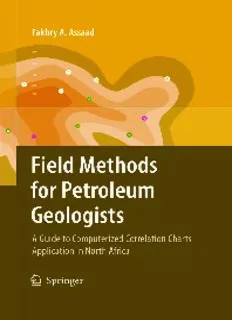Table Of ContentField Methods for Petroleum Geologists
Fakhry A. Assaad
Field Methods for
Petroleum Geologists
A Guide to Computerized
Lithostratigraphic Correlation Charts
Case Study: Northern Africa
FakhryA.Assaad
1350,37th,Str.EastTuscaloosa,
AL35405
USA
[email protected]
ISBN:978-3-540-78836-2 e-ISBN:978-3-540-78837-9
LibraryofCongressControlNumber:2008934328
(cid:2)c Springer-VerlagBerlinHeidelberg2009
Thisworkissubjecttocopyright.Allrightsarereserved,whetherthewholeorpartofthematerialis
concerned,specificallytherightsoftranslation,reprinting,reuseofillustrations,recitation,broadcasting,
reproductiononmicrofilmorinanyotherway,andstorageindatabanks.Duplicationofthispublication
orpartsthereofispermittedonlyundertheprovisionsoftheGermanCopyrightLawofSeptember9,
1965,initscurrentversion,andpermissionforusemustalwaysbeobtainedfromSpringer.Violationsare
liabletoprosecutionundertheGermanCopyrightLaw.
Theuseofgeneraldescriptivenames,registerednames,trademarks,etc.inthispublicationdoesnotimply,
evenintheabsenceofaspecificstatement,thatsuchnamesareexemptfromtherelevantprotectivelaws
andregulationsandthereforefreeforgeneraluse.
Coverdesign:deblik,Berlin
Printedonacid-freepaper
9 8 7 6 5 4 3 2 1
springer.com
PersonalDedication
ToPhilipE.LaMoreaux
ThisbookiscordiallydedicatedtoDr.PhilipE.LaMoreaux,the
formerState GeologistofAlabama, theformerpresidentofhisown
firm, PELA,andthechairmanofseveralscientificinstitutes allover
theUS.Iworkedwithhimasaco-expertattheUnitedNationsof
Egyptintheearly1960s,beinginchargeoftheGeologyDepartment
attheNewValleyProjectofthe WesternDesertandlateraschiefof
researchstudiesintheNorthwesternCoastalZoneofEgypttogether
withMr.ThomasJ.Joiner,theex-StateGeologistofAlabama.
ItwasapleasuretoworkpersonallywithPhilLaMoreauxinthe
early1980s, indifferentprojectsathisownfirmPELA,andlaterin
editorialactivitiesinvolvingscientificarticlesandbookreviewsof
recentpublications, issuedbyTheEnvironmentalGeology Journal
ofSpringer-Verlag.Hisscientificsupportandencouragementwere
appreciatedforproducingthebookFieldMethodsforGeologists and
Hydrogeologists,publishedbySpringer-Verlag,Heidelberg,Germany,
2003,togetherwithotherbooks;asaco-authorofatextbook
EnvironmentalHydrogeology,publishedbyTaylorFrancisGroup,
LLCCo.1995;andasasenioreditorofthebookAnnotated
Bibliography ofKarstTerranes,Vol. 5-1,publishedbythe
International AssociationofHydrogeologists, VerlagHeinzHeise,
Hannover,Germany,1993—alottolearnfrom hisprofessional
experience.
FakhryA.Assaad
v
Preface
The author worked at Sonatrach of Algeria (Societe´ National de Transport et de
Hydrocarbures) for seven consecutive contracts over more than a decade, being in
charge of the Triassic Province of Algeria, besides having responsibility for the
Database Retrieval System (PetroData System), established in 1970 by the Explo-
rationDirectorate.
The author started his career with Sonatrach as a District Geologist Engineer in
northern Algeria, and later worked with an international group from Technoexport
(1971)ontheTriassicProvinceoftheAlgerianSaharanplatform.
Severalprojectswereaccomplished:
1. In 1970–1972, he carried out detailed structural and stratigraphic studies of the
Triassic reservoirs, and defined the limits of deposition of the Triassic basin in
Algeria.
2. Later, he established a computer application for a lithostratigraphic correlation
chartofthesedimentaryformation(31/ ×1/)m,asatypemodelfortheArabian
2 2
Maghreb region (northwestern Africa), which can be further extended to cover
NorthAfrica.
3. HewasinchargeoftheDatabaseRetrievalSystem(PetroDataSystem),asaliai-
sonwiththeexplorationdistrictstosuperviseandmanagethequalityoftheinput
welldata,aswellasthegeological,drilling,productive,andgeophysicaldata,etc.,
inordertodefineandformulateretrievalrequestsforcomputerextractionproce-
dures. He provided corrections and improvements to refine the edit, validation,
andcrosscheckfunctionsofthemaintenancesubsystem.
vii
Acknowledgement
TheauthorisquitegratefulforthequickresponsefromDr.KhalilChekib,theAlge-
rianMinisterofPetroleumandEnergy,andDr.H.Chebourou,theDirectorof“Etudes
et Synthe´se” of the Exploration Division of Sonatrach, Algiers, for updating docu-
mentsnecessarytothe book.
Myhighestgratitudetomycollege’sgeologistDr.AliWerwer,thechairmanand
CEOoftheResearchGroundwaterCo.,(REGWA),Cairo;andProfessorDr.Hamed
Metwalli,ofthePetroleumGeologyDepartment,FacultyofScience,CairoUniver-
sity,fortheirsincerehelpinprovidingimportantmaterialsforthe book.
My special gratitude to Mr. John Sandy, the director of the Rodgers Library for
ScienceandEngineering,UniversityofAlabama;andtoMr.LewisS.Dean,thehead
oftheLibraryoftheGeologySurveyofAlabama(GSA),forprovidingmepromptly
withtheneededreferences.
ix
Contents
PartI PetroleumExplorationMethods
1 Introduction—PetroleumHydrocarbons............................ 3
1.1 HistoricalAspect........................................... 3
1.2 PetroleumOccurrenceandChemicalComposition............... 3
1.3 PropertiesofCrudeOils ..................................... 4
1.4 NaturalGas—Definition..................................... 4
1.5 PetroleumHydrocarbonNon-ReservoirRocks .................. 5
1.6 PetroleumReservoirRocks .................................. 5
1.7 PetroleumMigrationandAccumulation........................ 5
1.7.1 Introduction......................................... 5
1.7.2 OilMigration ....................................... 6
1.7.3 TheRoleofConnateWater............................ 6
1.7.4 DifferentialEntrapmentofPetroleumHydrocarbons—
GussowTheory ..................................... 6
1.7.5 PetroleumAccumulation.............................. 7
1.8 TheCapacityofOilandGasTraps ............................ 8
1.9 PetroleumProvince—Definition .............................. 9
References ....................................................... 9
2 SedimentaryBasinsandPlateTectonics ............................ 11
2.1 Scope .................................................... 11
2.2 ContinentalShelves......................................... 12
2.3 PlateInteractions........................................... 12
2.4 DevelopmentofSedimentaryBasins........................... 14
2.4.1 GeodynamicSettingsofSedimentaryBasins ............. 15
2.4.2 SedimentaryBasinsandHydrocarbonOccurrences........ 16
2.5 OilMigrationandSubduction ................................ 17
2.6 Rifted-MarginSedimentPrisms............................... 17
References ....................................................... 19
3 SurfaceGeophysicalPetroleumExplorationMethods ................ 21
3.1 Introduction ............................................... 21
xi
xii Contents
3.2 MagneticSurvey ........................................... 21
3.3 GravimetricSurvey ......................................... 21
3.4 SeismicExplorationSurvey.................................. 22
3.4.1 General ............................................ 22
3.4.2 SeismicRefractionMethods ........................... 22
3.4.3 SeismicReflectionMethod ............................ 22
3.5 Land-SatelliteImagesinSaltDomeExploration................. 23
References ....................................................... 23
4 DrillingTechnologyinPetroleumGeology .......................... 25
4.1 Introduction ............................................... 25
4.2 PetroleumDrillingOperations................................ 27
4.2.1 Discussion.......................................... 27
4.2.2 TypesofDrillingOperations........................... 28
4.3 DrillingFluids ............................................. 29
4.3.1 PropertiesofDrillingMuds............................ 29
4.3.2 CompositionandNatureoftheDrillingFluids............ 29
4.3.3 MudSystemsinSaltStructures ........................ 30
4.3.4 SaltDomeDrilling................................... 31
4.4 DrillingHazards ........................................... 31
4.5 DrillStemTesting(DST) .................................... 31
4.5.1 Scope.............................................. 31
4.5.2 Discussion.......................................... 32
4.6 GeneralRemarks........................................... 33
4.6.1 AbouttheDST—Procedure............................ 33
4.6.2 RequiredConditionsandReasonsforCarryingOuta
DSTinaPetroleumReservoirFormation ............... 34
References ....................................................... 40
5 GeophysicalWellLoggingMethodsofOilandGasReservoirs......... 41
5.1 Introduction ............................................... 41
5.2 BoreholeParametersandRockProperties ...................... 41
5.3 ResistivityMeasurementsbyWellElectricLogs................. 43
5.3.1 Definition .......................................... 43
5.3.2 AnnulusandResistivityProfiles—HydrocarbonZone...... 43
5.4 FormationTemperature(T ).................................. 44
f
5.5 SpecificLogTypes ......................................... 45
5.5.1 SpontaneousPotentialLogs(SP) ....................... 45
5.5.2 ResistivityLogs(R) .................................. 45
5.5.3 PorosityLogs ....................................... 48
5.5.4 GammaRayLogs.................................... 50
5.6 WellDesignandWellTypeCompletions ....................... 51
5.6.1 Scope.............................................. 51
5.6.2 OpenHoleCompletions .............................. 52
5.6.3 PerforatedCompletions............................... 52
5.6.4 ScreeningTechniques ................................ 52
5.6.5 OtherTypeWellCompletions.......................... 54
References ....................................................... 54
Contents xiii
Part II A Guide to Lithiostratigraphic Correlation Charts – A Model
Type/NorthAfrica
6 ALithostratigraphicCorrelationChart—AModelType/NorthAfrica . 57
6.1 Introduction ............................................... 57
6.1.1 Aspect ............................................. 57
6.1.2 PetroleumPerspective ................................ 58
6.2 GeologyofAlgeria ......................................... 61
6.2.1 TectonicHistory..................................... 61
6.2.2 StructuralGeologyofAlgeria.......................... 61
6.2.3 GeologicProvincesoftheAlgerianSahara............... 63
6.2.4 AnApproachtoaComputerizedLithostratigraphicChart
inNorthAfrica ..................................... 66
6.2.5 StratigraphyoftheAlgerianSaharanPlatform ............ 71
6.2.6 A Geological Study of An Exploratory Well at the
EasternBorderoftheAlgerianSahara(Ry-1)............ 72
6.3 PetroleumGeologyoftheLibyanSahara....................... 72
6.3.1 Scope.............................................. 72
6.3.2 StratigraphyofSebhaAreaWestofLibya ............... 74
6.4 PetroleumGeologyofEgypt,NortheastAfrica .................. 76
6.4.1 TheWesternDesertofEgypt .......................... 76
6.4.2 Geological Results of the Petroleum Exploration
oftheAssiut-KhargaWell ............................ 79
6.4.3 TheNileDeltaofEgypt............................... 81
6.4.4 TheGulfofSuezRegion,Egypt........................ 83
6.5 EconomicAspectsofSaltStructures........................... 87
References ....................................................... 87
Appendix ........................................................ 89
7 ThePetrodataDataBaseSystem ................................... 91
7.1 Scope .................................................... 91
7.2 ThePetrodataSystem ....................................... 91
7.2.1 HistoricalAspect .................................... 91
7.2.2 ClassificationofthePetrodataSystem................... 92
7.3 EconomicAspects.......................................... 98
7.4 Recommendation........................................... 98
7.5 ATypeComputerizedMontageDrillingReportofanExploratory
Well(Boumahniwell“Bi-1”) ................................ 99
7.6 AppendixA ...............................................101
References .......................................................106
Glossary.............................................................107
Index................................................................111
Description:Provides an introduction to petroleum exploration methods, referring to both geophysical and geochemical techniques and the logistics of various drilling techniques and well logging methods for oil and gas exploration. The second part of the book focuses on using these methods for petroleum explorat

